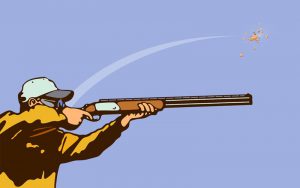Part III: Firearms Rights Restoration – Making a Constitutional Challenge to Restore Your Right to Own or Possess in North Carolina
By KevinMarcilliat, In Criminal Defense, 0 Comments
SECOND AMENDMENT: SUBJECT OF HOT DEBATE
Debating the Second Amendment is not something we will do here. All we will say is that the Second Amendment is open to interpretation based on history and context. Well-meaning people can argue that the average law-abiding citizen has the inviolable right to own or possess a firearm. Other well-meaning people may argue that the right only goes so far, or does not apply to the individual citizen at all.
THIS READER’S COMMENT IS AN EXAMPLE
A reader’s comment on our Facebook page said that we “should know better” (because we’re a law firm) than to claim that citizens have a constitutional right to keep and bear arms, as in own or possess a personal firearm. He argued that the text of the Second Amendment, circa 1791, meant that citizens have a right to store and bear arms for the time when the militia calls them into military service.
We won’t argue with him. He may be right.
But the U.S. Supreme Court has not given the Second Amendment that meaning through its current interpretation. Nor have the majority of lower courts and state legislatures over the course of U.S. history. Suffice it to say, individual citizens today have a legal right to own and possess a firearm for personal defense, for use as a hobby, to hunt, etc.
RESTORING YOUR GUN RIGHTS UNDER NORTH CAROLINA LAW
We can debate the Second Amendment until we’re blue in the face. But the fact remains that one group of “law abiding” American citizens may own or possess a firearm and another rather large group of people (those once convicted of a felony offense) may not. This second group may not legally own or possess for any reason, even if they are otherwise law abiding and nonviolent. Even if they pose no real threat to public safety.
As we explained in Part II of this series, North Carolina’s firearms rights restoration process allows for certain citizens to once again legally own or possess a firearm. In general, three requirements largely determine whether you’re a good candidate for restoration (see Part II for more).
THE CONSTITUTIONAL ARGUMENT
What happens if you are rejected? What happens if it’s a “close case”? For example, having committed two felonies (rather than just one) would disqualify a person under the five-factor test (even if the felonies were both nonviolent), but does not by itself necessarily show that the person poses a threat to public safety. It may be worth making a constitutional claim. To be clear, this is not the usual course of action, but we are ready and prepared to do so in the right circumstances.
In general, the argument is that the five-factor test is too narrow, and that the proper standard is for the court to make its determination based on an individual, case-by-case basis, looking at all the facts and circumstances, not just whether the petitioner satisfies five factors. The court would determine whether, in the face of evidence showing otherwise, that the petitioner is “in reality so dangerous that any possession at all of a firearm would pose a significant threat to public safety,” as the North Carolina Supreme Court wrote in the case of Britt v. State.
WHY WE ARE ADVERTISING FOR THESE CASES
If our series on firearms rights restoration was in any way helpful to you, and you’re wondering whether you have a shot at restoring your rights in North Carolina, give us a call at 877-204-5365.
Our “sales pitch” is simple: We believe in due process and fairness for everyone, even those society calls “criminals.” And we believe that we can help people who made a mistake in the past, but who turned their lives around, restore their rights to responsible gun possession and ownership.
Marcilliat & Mills PLLC is a law firm of state and federal criminal defense attorneys based in Raleigh and Charlotte, North Carolina. We serve clients throughout the state and nationwide in select cases. Click here for Part I and Part II of our series on firearms rights restoration.









